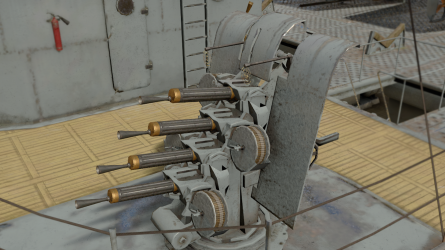Vickers Mk.V (12.7 mm)

Contents
Description
The Vickers Mk.V is a naval anti-aircraft machine gun.
Vehicles equipped with this weapon
| Vehicles equipped with this weapon | |
|---|---|
| Motor gun boats | Fairmile C (312) · Fairmile D (601) · Fairmile H LCS(L)(2) · MGB-61 · SGB Grey Fox · SGB Grey Goose |
| Motor torpedo boats | Fairmile D (617) · Fairmile D (697) · Fairmile D (5001) · MTB Vosper(2) |
| Destroyers | HMS Grafton · HMS Kelvin · HMS Eskimo · HMS Mohawk · HMS Verdun |
| Light cruisers | HMNZS Leander · HMS Southampton · Krasny Kavkaz · Krasny Krym · Voroshilov |
| Heavy cruisers | HMS Kent · HMS York |
| Battlecruisers | HMS Hood |
General info
Tell us about the tactical and technical characteristics of the cannon or machine gun.
Available ammunition
Describe the shells that are available for the weapon and their features and purpose. If it concerns autocannons or machine guns, write about different ammo belts and what is inside (which types of shells).
Comparison with analogues
Give a comparative description of cannons/machine guns that have firepower equal to this weapon.
Usage in battles
Describe the cannon/machine gun in the game - its distinctive features, tactics of usage against notable opponents. Please don't write a "guide" - do not impose a single point of view, but give the reader food for thought.
Pros and cons
Summarise and briefly evaluate the weaponry in terms of its characteristics and combat effectiveness. Mark pros and cons as a list.
Pros:
Cons:
History
During World War I, both the Allied and Central Powers worked on developing large caliber rifles for anti-aircraft, aircraft, and anti-tank use. The Germans were the first to finish such a weapon and the only ones to get it into service during the war with the Mauser 1918 Tankgewehr anti-tank rifles. However, the United Kingdom was not too far behind and was developing a .50 scaled-up version of the Vickers heavy machine gun that was World War I's mainstay. Development continued at a slowed pace after the war ended and the need became more apparent with the new wave of light tanks built during the 1920s and 1930s. British light tank development during the interwar period operated under the assumption that the light tanks would as scouts primarily and would be used in combat against other light tanks. At the time, most European light tanks had .47-.55 inches of armor, so the armament of the Light Tank Mark V had to be increased from the World War I-era Vickers .303 to a .50 Vickers Mark II. Through different variants based on this design, the Vickers Mk. V was born. Chambered for a 12.7x80mm cartridge the Vickers Mark V is the main weapon for the British Light Tank Mk.VI Vickers built in-house for the Royal Tank Corps. While it was capable of penetrating early German armor during World War II, it was quickly rendered obsolete. The replacement on the later light tank starting with the Tetrarch I was the QF 2-pounder anti-tank gun.
However, the Vickers .50 would also see naval service. The Royal Navy used a variant called the Mark III a quad-mount design that later was used in twin or single mounts, the Mark III began production in 1926 but didn't enter service until 1932. The Mark III was designed following the inter-war doctrine of using heavy machine guns as close-range anti-aircraft weapons on warships. The guns had 200 magazines per barrel with a 700-round per minute cyclic rate for each gun on the mount. It wasn't long after World War II began that the Royal Navy realized these guns were not effective at shooting down modern aircraft and they moved on to the more powerful 20 mm/70 Oerlikon Mk.II to serve as their anti-aircraft gun on their large warships. However, 12,500 Mark IIIs were ultimately built and served through the war even longer than their tank counterparts. Their primary use was to arm smaller boats such as the Fairmille Motor Launches and MTBs of the Coastal Forces.
Media
An excellent addition to the article would be a video guide, as well as screenshots from the game and photos.
See also
Links to the articles on the War Thunder Wiki that you think will be useful for the reader, for example:
- reference to the article about the variant of the cannon/machine gun;
- references to approximate analogues by other nations and research trees.
External links
Paste links to sources and external resources, such as:
- topic on the official game forum;
- other literature.
| Naval machine guns | |
|---|---|
| USA | |
| 7.62 mm | M73 |
| 12.7 mm | AN-M2 |
| Germany | |
| 7.62 mm | MG-3 |
| 7.92 mm | MG08 pattern 1908 · MG15 · MG34 |
| 13.2 mm | Hotchkiss |
| 15 mm | MG M38(t) |
| USSR | |
| 7.62 mm | Maxim |
| 12.7 mm | DShK |
| 14.5 mm | KPV |
| Britain | |
| 7.62 mm | FN MAG |
| 7.7 mm | Lewis 1916 · Vickers GO No.5 |
| 12.7 mm | Vickers Mk.V |
| Japan | |
| 6.5 mm | Maxim · Type 38 pattern 1907 |
| 7.7 mm | Type 89 · Type 92 |
| 13.2 mm | Type 93 |
| Italy | |
| 6.5 mm | Breda Mod.30 · Fiat Model 26 |
| 12.7 mm | Breda-SAFAT |
| 13.2 mm | Breda Model 31 |
| France | |
| 7.7 mm | Darne M1922 |
| 7.92 mm | Hotchkiss pattern 1914 |
| 13.2 mm | Browning · Model 1929 Hotchkiss |



